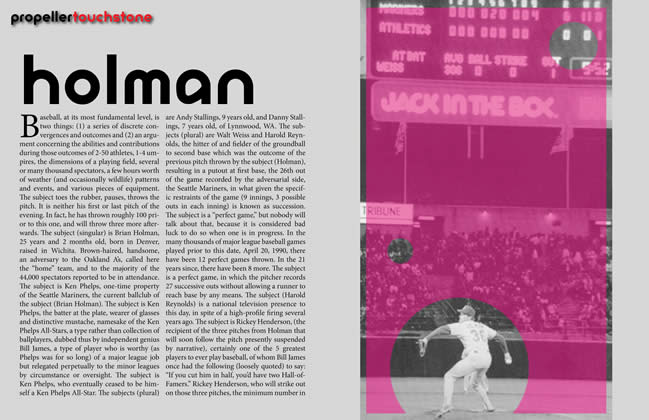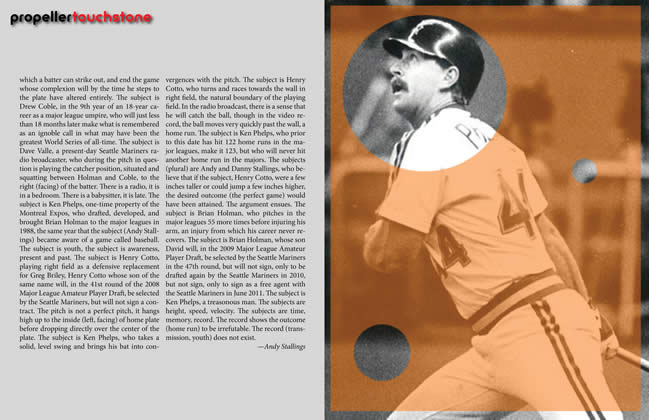
Baseball, at its most fundamental level, is two things: (1) a series of discrete convergences and outcomes and (2) an argument concerning the abilities and contributions during those outcomes of 2-50 athletes, 1-4 umpires, the dimensions of a playing field, several or many thousand spectators, a few hours worth of weather (and occasionally wildlife) patterns and events, and various pieces of equipment. The subject toes the rubber, pauses, throws the pitch. It is neither his first or last pitch of the evening. In fact, he has thrown roughly 100 prior to this one, and will throw three more afterwards. The subject (singular) is Brian Holman, 25 years and 2 months old, born in Denver, raised in Wichita. Brown-haired, handsome, an adversary to the Oakland A's, called here the "home" team, and to the majority of the 44,000 spectators reported to be in attendance. The subject is Ken Phelps, one-time property of the Seattle Mariners, the current ballclub of the subject (Brian Holman). The subject is Ken Phelps, the batter at the plate, wearer of glasses and distinctive mustache, namesake of the Ken Phelps All-Stars, a type rather than collection of ballplayers, dubbed thus by independent genius Bill James, a type of player who is worthy (as Phelps was for so long) of a major league job but relegated perpetually to the minor leagues by circumstance or oversight. The subject is Ken Phelps, who eventually ceased to be himself a Ken Phelps All-Star. The subjects (plural) are Andy Stallings, 9 years old, and Danny Stallings, 7 years old, of Lynnwood, WA. The subjects (plural) are Walt Weiss and Harold Reynolds, the hitter of and fielder of the groundball to second base which was the outcome of the previous pitch thrown by the subject (Holman), resulting in a putout at first base, the 26th out of the game recorded by the adversarial side, the Seattle Mariners, in what given the specific restraints of the game (9 innings, 3 possible outs in each inning) is known as succession. The subject is a "perfect game," but nobody will talk about that, because it is considered bad luck to do so when one is in progress. In the many thousands of major league baseball games played prior to this date, April 20, 1990, there have been 12 perfect games thrown. In the 21 years since, there have been 8 more. The subject is a perfect game, in which the pitcher records 27 successive outs without allowing a runner to reach base by any means. The subject (Harold Reynolds) is a national television presence to this day, in spite of a high-profile firing several years ago. The subject is Rickey Henderson, (the recipient of the three pitches from Holman that will soon follow the pitch presently suspended by narrative), certainly one of the 5 greatest players to ever play baseball, of whom Bill James once had the following (loosely quoted) to say: "If you cut him in half, you’d have two Hall-of-Famers." Rickey Henderson, who will strike out on those three pitches, the minimum number in which a batter can strike out, and end the game whose complexion will by the time he steps to the plate have altered entirely. The subject is Drew Coble, in the 9th year of an 18-year career as a major league umpire, who will just less than 18 months later make what is remembered as an ignoble call in what may have been the greatest World Series of all-time. The subject is Dave Valle, a present-day Seattle Mariners radio broadcaster, who during the pitch in question is playing the catcher position, situated and squatting between Holman and Coble, to the right (facing) of the batter. There is a radio, it is in a bedroom. There is a babysitter, it is late. The subject is Ken Phelps, one-time property of the Montreal Expos, who drafted, developed, and brought Brian Holman to the major leagues in 1988, the same year that the subject (Andy Stallings) became aware of a game called baseball. The subject is youth, the subject is awareness, present and past. The subject is Henry Cotto, playing right field as a defensive replacement for Greg Briley, Henry Cotto whose son of the same name will, in the 41st round of the 2008 Major League Amateur Player Draft, be selected by the Seattle Mariners, but will not sign a contract. The pitch is not a perfect pitch, it hangs high up to the inside (left, facing) of home plate before dropping directly over the center of the plate. The subject is Ken Phelps, who takes a solid, level swing and brings his bat into convergences with the pitch. The subject is Henry Cotto, who turns and races towards the wall in right field, the natural boundary of the playing field. In the radio broadcast, there is a sense that he will catch the ball, though in the video record, the ball moves very quickly past the wall, a home run. The subject is Ken Phelps, who prior to this date has hit 122 home runs in the major leagues, make it 123, but who will never hit another home run in the majors. The subjects (plural) are Andy and Danny Stallings, who believe that if the subject, Henry Cotto, were a few inches taller or could jump a few inches higher, the desired outcome (the perfect game) would have been attained. The argument ensues. The subject is Brian Holman, who pitches in the major leagues 55 more times before injuring his arm, an injury from which his career never recovers. The subject is Brian Holman, whose son David will, in the 2009 Major League Amateur Player Draft, be selected by the Seattle Mariners in the 47th round, but will not sign, only to be drafted again by the Seattle Mariners in 2010, but not sign, only to sign as a free agent with the Seattle Mariners in June 2011. The subject is Ken Phelps, a treasonous man. The subjects are height, speed, velocity. The subjects are time, memory, record. The record shows the outcome (home run) to be irrefutable. The record (transmission, youth) does not exist.
—Andy Stallings

Andy Stallings lives in New Orleans, where he teaches poetry and has a family but spends most of his free time thinking about baseball.


